NCERT Solutions for Chapter 13 Surface Areas and Volumes Class 9 Maths
Book Solutions1
(i) The area of the sheet required for making the box.
(ii) The cost of sheet for it, if a sheet measuring 1 m2 costs ₹ 20.
Answer
(i) Here, l = 1.5 m,b = 1.25 m
h = 65 cm = (65/100) m = 0.65 m
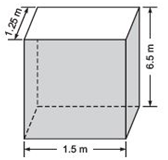
∵ It is open from the top.
∵ Its surface area = [Lateral surface area] + [Base area]
= [2(l + b)h] + [l × b]
= [2(1.50 + 1.25)0.65 m2] + [1.50 x 1.25 m2]
= [2 x 2.75 x 0.65 m2] + [1. 875 m2]
= 3.575 m2 + 1.875 m2 = 5.45 m2
∵ The total surface area of the box = 5.45 m2
∴ Area of the sheet required for making the box = 5.45 m2
(ii) ∵ Rate of sheet = ₹ 20 per m2
∴ Cost of 5.45 m2 = ₹ 20 x 5.45
⇒ Cost of the required sheet = ₹ 109
2
Answer
Length of the room (l)= 5m Breadth of the room (b) = 4 mHeight of the room (h) = 3 m
The room is like a cuboid whose four walls (lateral surface) and ceiling are to be white washed.
∴ Area for white washing = [Lateral surface area] + [Area of the ceiling]
= [2(l + b)h] + [l x b]
= [2(5 + 4) x 3 m2] + [5 x 4 m2]
= [54 m2] + [20 m2] = 74 m2
Cost of white washing: Cost of white washing for 1 m2 = ₹ 7.50
∴ Cost of white washing for 74 m2 = ₹ 7.50 x 74
= ₹ 555
The required cost of white washing is ₹555.
3
Answer
Note: Area of four walls = Lateral surface area.A rectangular hall means a cubiod.
Let the length and breadth of the hall be ‘l’ and ‘b’ respectively.
∴ [Perimeter of the floor] = 2(l + b) ⇒ 2(l + b) = 250 m.
∵ Area of four walls = Lateral surface area = [2(l + b)] x h [where ‘h’ is the height of hall.]
∴ Cost of painting the four walls = ₹ 10 x 250 h = ₹ 2500 h
⇒₹2500 h = ₹ 15000
4
Answer
Total area that can be painted = 9.375 m2, since a brick is like a cuboid∴ Total surface area of a brick = 2[lb + bh + hl]
= 2[(22.5 x 10) + (10 x 7.5) + (7.5 x 22.5)] cm2
= 2[(225) + (75) + (168.75)] cm2
= 2[468.75] cm2
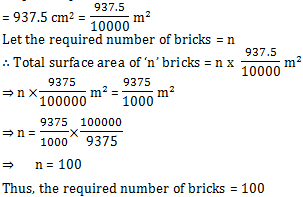
5
(i) Which box has the greater lateral surface area and by how much?
(ii) Which box has the smaller total surface area and by how much?
Answer
For the cubical box∵ Edge of the cubical box = 10 cm
∴ Lateral surface area = 4a2
= 4 × 102 cm2
= 4 × 100 cm2
= 400 cm2
Total surface area = 6a2
= 6 × 102 = 6 × 100 cm2 = 600 cm2
∵ For the cuboidal box,
l = 12.5 cm, b = 10 cm, h = 8 cm
∴ Lateral surface area = 2[(l + b)] x h
= 2[12.5 + 10] × 8 cm2
= 2[22.5 x 8] cm2 = 360 cm2
Total surface area = 2[lb + bh + hl]
= 2[(12.5 × 10) + (10 x 8) + (8×12.5)] cm2
= 2[125 + 80 + 100] cm2
= 2[305] cm2
= 610 cm2
Obviously,
(i) ∵ 400 cm2 > 360 cm2 and 400 – 360 = 40
∴ The cubical box, has greater lateral surface area by 40 m2
(ii) ∵ 610 cm2 > 600 cm2 and 610 – 600 = 10
∴ The cuboidal box has greater total surface area by 10 m2
6
(i) What is the area of the glass?
(ii) How much of tape is needed for all the 12 edges?
Answer
The herbarium is like a cuboid Here, l = 30 cm, b = 25 cm, h = 25 cm(i) ∵ Area of a cuboid = 2[lb + bh + hl]
∴ Surface area of the herbarium (glass) = 2[(30 × 25) + (25 × 25) + (25 × 30)] cm2
= 2[750 + 625 + 750] cm2
= 2[2125] cm2
= 4250 cm2
Thus, the required area of glass is 4250 cm2.
(ii) Total length of 12 edges = 4l + 4b + 4h = 4(l + b + h)
= 4(30 + 25 + 25) cm
= 4 × 80 cm = 320 cm
Thus, length of tape needed = 320 cm
7
Answer
For bigger box:Length (l) = 25 cm,
Breadth (b) = 20 cm,
Height (h) = 5 cm
∵ The box is like a cuboid and total surface area of a cuboid
= 2(lb + bh + hl)
∴ Area of a box = 2([25 × 20) + (20 x 5) + (5 × 25)] cm2
= 2[500 + 100 + 125] cm2
= 2[725] cm2
= 1450 cm2
⇒ Total surface area of 250 boxes = 250 × 1450 cm2
= 362500 cm2
For smaller box:
l = 15 cm, b = 12 cm, h = 5 cm
Total surface area of a box = 2[lb + bh + hl]
= 2[(15 × 12) + (12 × 5) + (5 × 15)]cm2
= 2[180 + 60 + 75] cm2
= 2[315] cm2
= 630 cm2
⇒ Total surface area of 250 boxes = 250 x 630 cm2 = 157500 cm2
Now, total surface area of both kinds of boxes = 362500 cm2 + 157500 cm2
= 5,20,000 cm2
Area for overlaps = 5% of [total surface area]
= (5/100)x 520000 cm2 = 26000 cm2
∴ Total area of the cardboard required = [Total area of 250 boxes] + [5% of total surface area]
= 520000 cm2 + 26000 cm2
= 546000 cm2
Cost of cardboard:
∵ Cost of 1000 cm2 = ₹ 4
∴ Cost of 546000 cm2
= (4/546000)/ 1000
= ₹ 4×546
= ₹ 2184
8
Answer
Here, height (h) = 2.5 mBase dimension = 4 m × 3 m
⇒ Length (l) = 4 m and
Breadth (b) = 3 m
∵ The structure is like a cuboid.
∴ The surface area of the cuboid, excluding the base
= [Lateral surface area] + [Area of ceiling]
= [2 (l + b)h] + [lb]
= [2 (4 + 3) × 2.5] + [4 x 3] m2
= [35] + [12] m2
= 47 m2
Thus, 47 m2 tarpaulin would be required.
When axis of a cylinder is perpendicular to the base radius then it is called a right circular cylinder.
If ‘r’ and ‘h’ be the radius and height of a cylinder respectively, then (i) Base area (= top area) = πr2
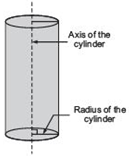
(ii) Curved surface area (Lateral surface area) of a cylinder = 2πrh
(iii) Total surface area of a cylinder = 2πrh + 2πr2 = 2πr(h + r)
Note: Unless it is mentioned assume π = (22/7)
1
Answer
Let ‘r ’ be the radius of the cylinder.Here, height (h) = 14 cm and curved surface area = 88 cm2
∵ Curved surface area of a cylinder = 2πrh
∴ 2 πrh = 88
2
Answer
Here, height (h) = 1 m∵ Diameter of the base = 140 cm = 1.40 m
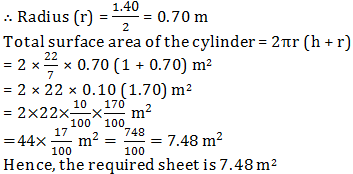
3
(i) inner curved surface area,
(ii) outer curved surface area,
(iii) total surface area.
Answer
Length of the metal pipe = 77 cm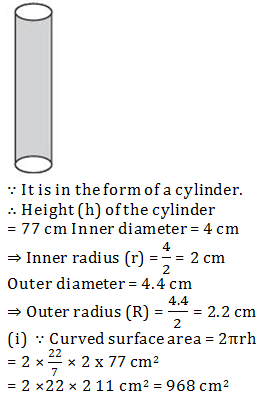
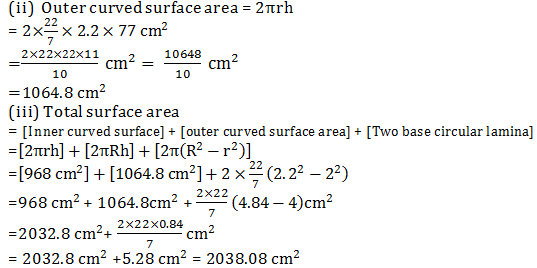
4
Answer
The roller is in the form of a cylinder diameter of the roller = 84 cm⇒ Radius of the cylinder =(84/2) = 42 cm
Length of the roller = 120 cm
⇒ Height of the cylinder (h) = 120 cm
∴ Curved surface area of the roller (cylinder) = 2 πrh
= 2 × 22 × 6 × 120 cm2
= 31680 cm2
∴ Area of the playground levelled in one revolution of the roller = 31680 cm2

5
Answer
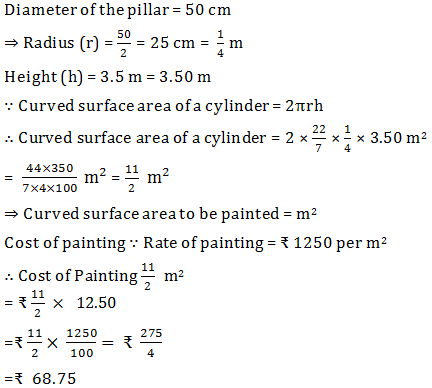
6
Answer
Radius (r) = 0.7 m Let height of the cylinder be ‘h’ metres.∴ Curved surface area = 2πrh
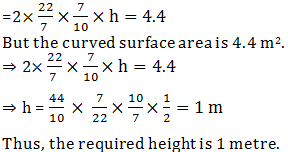
7
(i) its inner curved surface area.
(ii) the cost of plastering this curved surface at the rate of 40 per m2.
Answer
Inner diameter of the well = 3.5 m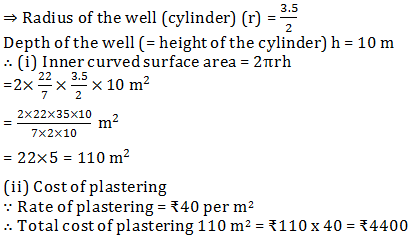
8
Answer
Length of the cylindrical pipe = 28 m⇒ h = 28 m
Diameter of the pipe = 5 cm
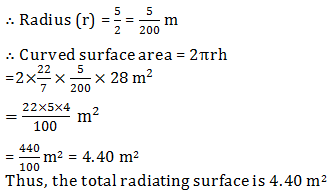
9
(i) the lateral or curved surface area of a closed cylindrical petrol storage tank that is 4.2 m in diameter and 4.5 m high.
(ii) how much steel was actually used if (1/12) of the steel actually used was wasted in making the tank.
Answer
The storage tank is in the form of a cylinder, and diameter of the tank = 4.2 m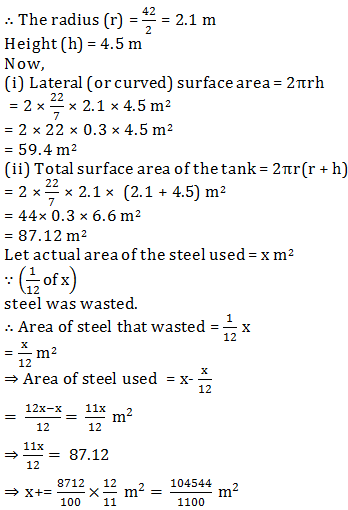
Thus, the required area of the steel that was actually used is 95.04 m2
10
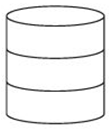
Answer
The lampshade is in the form of a cylinder, where
Height = 30 cm.
∵ A margin of 2.5 cm is to be added to top and bottom.
∴ Total height of the cylinder h = 30 cm + 2.5 cm + 2.5 cm = 35 cm
Now, curved surface area = 2 πrh
= 2 × 22 × 10 × 5 cm2
= 2200 cm2
Thus, the required area of the cloth = 2200 cm2
11
Answer
Here, the penholders are in the form of cylinders Radius of a cylinder (r) = 3 cmHeight of a cylinder (h) = 10.5 cm
Since, a penholder must be open from the top.
∴ Surface area of a penholder (cylinder) = [Lateral surface area] + [Base area]
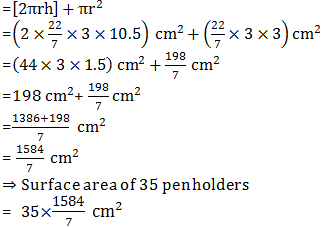
= 5 × 1584 cm2
= 7920 cm2 [∵ There are 35 competitors]
Thus, 7920 cm2 of cardboard was required to be bought.
1
Answer
Here, diameter of the base = 10.5 cmSlant height (l) = 10 cm
∴ Curvered surface area of the cone = πrl

2
Answer
Here, diameter = 24 m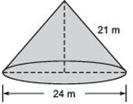

3
(i) radius of the base and
(ii) total surface area of the cone.
Answer
Here, curved surface area = 308 cm2Slant height (l) = 14 cm
(i) Let the radius of the base be ‘r’ cm.
∴ πrl = 308
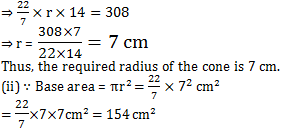
and curved surface area = 308 cm2 [Given]
∴ Total surface area
= [Curved surface area] + [Base area]
= 308 cm2 + 154 cm2
= 462 cm2
4
(i) slant height of the tent.
(ii) cost of the canvas required to make the tent, if the cost of 1 m2 canvas is ₹ 70.
Answer
Here, height of the tent (h) = 10 mRadius of the base (r) = 24 m
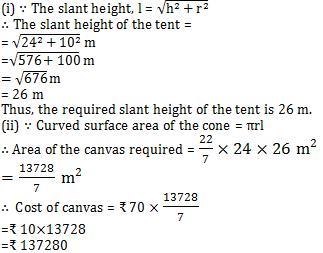
5
Answer
Here, Base radius (r) = 6 mHeight (h) = 8 m
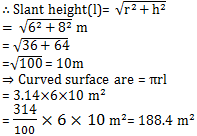
∴ Area of the canvas (tarpaulin) required to make the tent = 188.4 m2
Let the length of the tarpaulin = ‘L’ m
∴ Length x Breadth = 188.4
⇒ L x 3 = 188.4
⇒ L= (188.4/3) = 62.8 m
Extra length of tarpaulin for margins = 20 cm = (20/100) m = 0.2 m
Thus, total length of tarpaulin required = 62.8 m + 0.2 m = 63.0 m
6
Find the cost of white washing its curved surface at the rate of ₹ 210 per 100 m2.
Answer

= 22 × 25 m2 = 550 m2
Cost of white washing:
Rate of whitewashing = ₹ 210 per 100 m2
∴ Cost of whitewashing for 550 m2
7
Answer
Here, Radius of the base (r) = 7 cmheight (h) = 24 cm
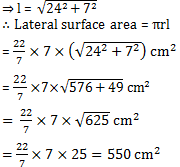
⇒ Lateral surface area of 10 caps = 10 x 550 cm2 = 5500 cm2
Thus, the required area of the sheet = 5500 cm2
8
Answer
Here, ∵ Diameter of the base = 40 cm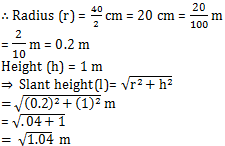
= 1.02 m [∵ √1.04= 1.02 (Given)]
Now, curved surface area = πrl
⇒ Curved surface area of 1 cone = 3.14 x 0.2 x 1.02 m2

1
(i) 10.5 cm
(ii) 5.6 cm
(iii) 14 cm
Answer
(i) Here r = 10.5 cm∴ Surface area of the sphere = 4πr2
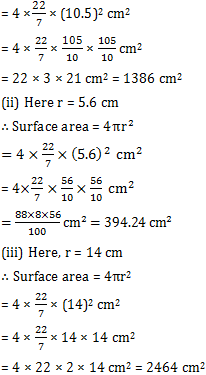
2
(ii) 21 cm
(iii) 3.5 m
Answer
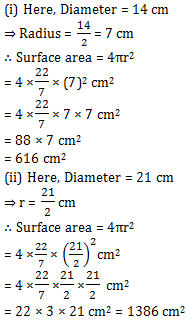

3
Answer
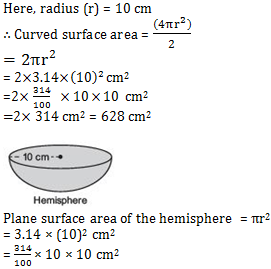
= 314 cm2
∴ Total surface area = 628 cm2 + 314 cm2
= 942 cm2
REMEMBER
(i) Curved surface area of a hemisphere = 2πr2
(ii) Total surface area of a hemisphere = 3πr2
4
Answer
Case I: When radius (r1) = 7 cm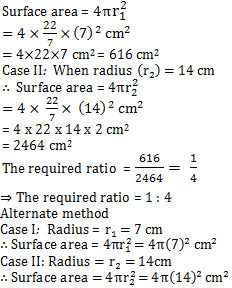
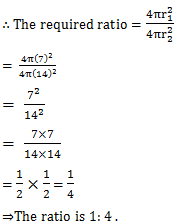
5
Answer
Inner diameter of the hemisphere = 10.5 m∵ Curved surface area of a hemisphere = 2πr2
∴ Inner curved surface area of hemispherical bowl
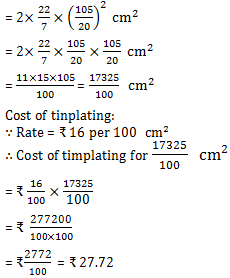
6
Answer
Let the radius of the sphere be ‘r’ cm.∴ Surface area = 4πr2
⇒ 4πr2 = 154
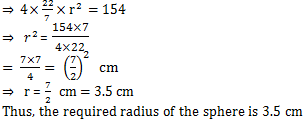
7
Answer
Let the radius of the earth = r∴ Radius of the moon = (r/4)
∵ Surface area of a sphere = 4πr2
Since, the earth as well as the moon are considered to be spheres.
∴ Surface area of the earth = 4πr2
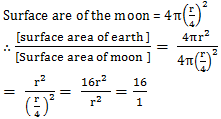
⇒ [Surface area of the moon] : [Surface area of the earth] = 1 : 16
Thus, the required ratio = 1 : 16
8
Answer
Inner radius (r) = 5cmThickness = 0.25 cm
∴ Outer radius (R) = [5.00 + 0.25] cm = 5.25 cm
∴ Outer surface area of the bowl = 2πr2

9
(i) surface area of the sphere,
(ii) curved surface area of the cylinder,
(iii) ratio of the areas obtained in (i) and (ii).
Answer
(i) For the sphere: Radius = r∴ Surface area of the sphere = 4 πr2
(ii) For the right circular cylinder:
∵ Radius of the cylinder = Radius of the sphere
∴ Radius of the cylinder = r
Height of the cylinder = Diameter of the sphere
⇒ Height of the cylinder (h) = 2r
Since, curved surface area of a cylinder = 2πrh
= 2πr(2r)
= 4πr2
1
Answer
Measures of matchbox (cuboid) is 4 cm × 2.5 cm × 1.5 cm⇒ l = 4 cm,
b = 2.5 cm
h = 1.5 cm
∴ Volume of matchbox = (l x b) × h
= [4 cm × 2.5 cm] × 1.5 cm3
= 15 cm3
⇒ Volume of 12 boxes = 12 × 15 cm3
= 180 cm3
2
Answer
Here, Length (l)= 6 mBreadth (b) = 5 m
Depth (h) = 4.5 m
∴ Capacity = l x b x h
= 6 x 5 x 4.5 m3
= 3 x 45 = 135 m3
∵ 1 m3 can hold 1000 l.
∴ 135 m3 can hold (135 x 1000 l = 135000 l) of water.
∴ The required amount of water in the tank = 135000 l.
3
Answer
Length (l) = 10 mBreadth (b) = 8 m
Volume (v) = 380 m3
Let height of the cuboid be ‘h’.
Since, volume of a cuboid = l x b x h
∴ Volume of the cuboidal vessel = 10 x 8 x h m3 = 80h m3
⇒ 80h = 380
Thus, the required height of the liquid = 4.75 m
4
Answer
Length (l)= 8 mBreadth (b) = 6 m
Depth (h) = 3 m
∴ Volume of the cuboidal pit = l x b x h = 8 x 6 x 3 m3
= 144 m3
Since, rate of digging the pit is ₹ 30 per m3.
∴ Cost of digging = ₹ 30 x 144 = ₹ 4320
5
Answer
Length of the tank (l) = 2.5 mDepth of the tank (h) = 10 m
Let breadth of the tank = b m
∴ Volume (capacity) of the tank = l x b x h
= 2.5 x b x 10 m3
But the capacity of the tank = 50000 l
= 50 m3 [∵ 1000 l = 1 m3]
∴ 25b = 50 m3
6
It has a tank measuring 20 m × 15 m × 6 m. For how many days will the water of this tank last?
Answer
Length of the tank (l) = 20 mBreadth of the tank (b) = 15 m
Height of the tank (h) = 6 m
∴ Volume of the tank = l x b x h = 20 × 15 × 6 m3 = 1800 m3
Since, 1 m3 = 1000 l
∴ Capacity of the tank = 1800 × 1000 l = 1800000 l
Village population = 4000
Since, 150 l of water is required per head per day.
∴ Amount of water is required per day = 150 x 4000 l.
Let the required number of days = x
∴ 4000×150× x = 1800000
Thus, the required number of days is 3.
7
Answer
Volume of the godown = 60x 25 × 10 m3Volume of a crate = 1.5 × 1.25 × 0.5 m3
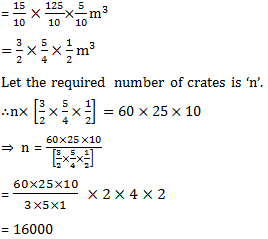
8
Answer
Side of the given cube = 12 cm∴ Volume of the given cube = (side)3 = (12)3 cm3
Side of the smaller cube:
Let the side of the new (smaller) cube = n
⇒ Volume of smaller cube = n3
⇒ Volume of 8 smaller cubes = 8n3
n3 = (6)3
n = 6
Thus, the required side of the new (smaller) cube is 6 cm.
Ratio between surface areas:
Surface area of the given cube = 6 × (side)2
= 6 × 122 cm2
= 6 × 12 × 12 cm2
Surface area of one smaller cube = 6 × (side)2
= 6 × 62 cm2
= 6 × 6 × 6 cm2
∴ Surface area of 8 smaller cubes = 8 × 6 × 6 × 6 cm2
Now,

Thus, the required ratio = 1:4
9
Answer
The water flowing in a river can be considered in the form of a cuboid
Such that Length (l) = 2 km = 2000 m
Breadth (b) = 40 m
Depth (h) = 3 m
∴ Water volume (volume of the cuboid so formed) = l x b x h = 2000 x 40 x 3 m3
Now, volume of water fallowing in 1 hr (= 60 minutes) = 2000 x 40 x 3 m3
∴ Volume of water that will fall in 1 minute
= [ 2000 ×40×3]÷60 m3
1
Answer
Let the base radius of the cylindrical vessel be ‘r’ cm.
∴ Circumference = 2πr
⇒ 2πr = 132 [∵ Circumference = 132 cm]
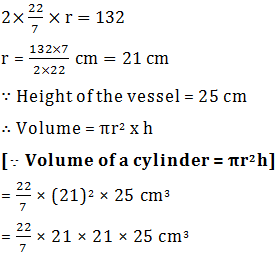
= 22 × 3 × 21 × 25 cm3
= 34650 cm3
∵ Capacity of the vessel = Volume of the vessel
∴ Capacity of cylindrical vessel = 34650 cm3
Since, 1000 cm3 = 1 litre
⇒ 34650 cm3
= (34650/1000) litres
= 34.65 L
2
Answer
Here, Inner diameter of the cylindrical pipe = 24 cm
⇒ Inner radius of the pipe (r) =![]() cm = 12 cm
cm = 12 cm
Outer diameter of the pipe = 28 cm
⇒ Outer radius of the pipe (R) =![]() cm = 14 cm
cm = 14 cm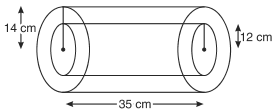
Length of the pipe (h) = 35 cm
∵ Inner volume of the pipe = πr2h
Outer volume of the pipe = πr2h
∴ Amount of wood (volume) in the pipe = Outer volume – Inner volume
= πR2h - πr2h
= πh(R2-r2)
= πh(R+r)(R-r) [∵ a2 - b2 = (a+b)(a-b)]![]()
= 22 × 5 × 26 × 2 cm3
Mass of the wood in the pipe
= [Mass of wood in 1 m3 of wood] × [Volume of wood in the pipe]
= [0.6g] × [22 × 5 × 26 × 2] cm3
= (6/10)× 22 × 10 × 26 g
= 6 × 22 × 26 g![]()
Thus, the required mass of the pipe is 3.432 kg.
3
(i) a tin can with a rectangular base of length 5 cm and width 4 cm, having a height of 15 cm and
(ii) a plastic cylinder with circular base of diameter 7 cm and height 10 cm. Which container has greater capacity and by how much?
Answer
For rectangular pack: Length (l) = 5 cmBreadth (b) = 4 cm Height (h) = 15 cm
∴ Volume = l x b x h
= 5 x 4 x 15 cm3
= 300 cm3
⇒ Capacity of the rectangular pack = 300 cm3 ...(1)
For cylindrical pack: Base diameter = 7 cm
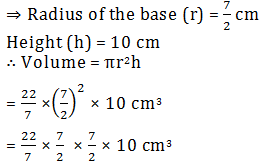
= 11 x 7 x 5 cm3 = 385 cm3
⇒ Volume of the cylindrical pack = 385 cm3 ...(2)
From (1) and (2),
we have 385 cm3 – 300 cm3 = 85 cm3
⇒ The cylindrical pack has the greater capacity by 85 cm3.
4
(i) radius of its base
(ii) its volume. (Use π = 3.14)
Answer
Height of the cylinder (h) = 5 cm Let the base radius of the cylinder be ‘r’.(i) Since lateral surface of the cylinder = 2 πrh
But lateral surface of the cylinder = 94.2 cm2
2πrh = 94.2

Thus, the radius of the cylinder = 3 cm
(ii) Volume of a cylinder = πr2h
⇒ Volume of the given cylinder = 3.14 x (3)2 x 5 cm3
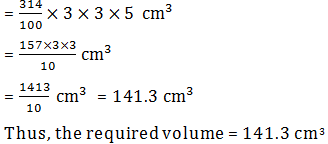
5
(i) inner curved surface of the vessel
(ii) radius of the base
(iii) capacity of the vessel.
Answer
(i) To find inner curved surfaceTotal cost of painting = ₹ 2200
Rate of painting = ₹ 20 per m2
⇒ Inner curved surface of the vessel = 110 m2
(ii) To find radius of the base Let the base radius of the cylindrical vessel.
∵ Curved surface of a cylinder = 2 πrh
∴ 2πrh = 110

⇒ The required radius of the base = 1.75 m
(iii) To find the capacity of the vessel
Since, volume of a cylinder = πr2h
∴ Volume (capacity) of the vessel
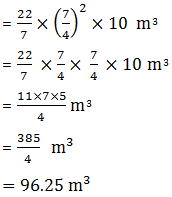
Since, 1 m3 = 1000000 cm3 = 1000 l = 1 kl
∴ 96.5 m3 = 96.5 kl
Thus, the required volume = 96.25 kl
6
Answer
Capacity of the cylindrical vessel = 15.4L= 15.4×1000 cm3
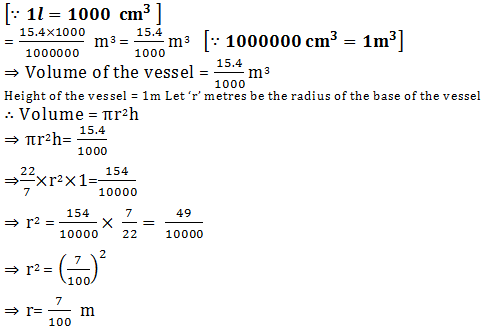

7
Answer
Since, 10 mm = 1cm∴ 1 mm = (1/10) cm
For graphite cylinder
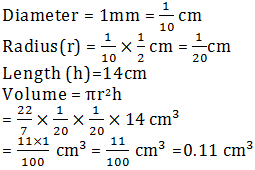
Thus,
the required volume of the graphite = 0.11 cm3
For the pencil Diameter of the pencil
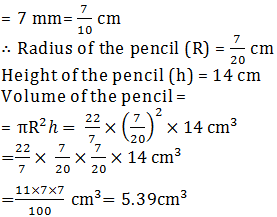
Volume of the wood Volume of the wood = [Volume of the pencil] – [Volume of the graphite]
= 5.39 cm3 – 0.11 cm3 = 5.28 cm3
Thus, the required volume of the wood is 5.28 cm3.
8
Answer
The bowl is cylindrical.Diameter of the base = 7 cm
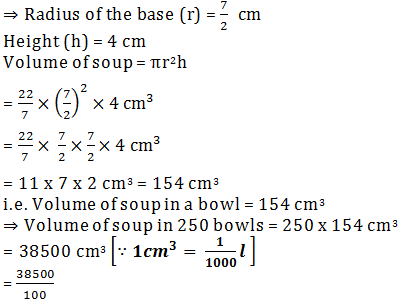
Thus, the hospital needs to prepare 38.5 litres of soup daily for 250 patients.
1
(i) radius 6 cm, height 7 cm
(ii) radius 3.5 cm, height 12 cm.
Answer
(i) Here, radius of the cone r = 6 cm Height (h) = 7 cm
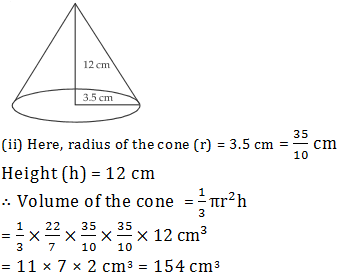
2
(i) radius 7 cm, slant height 25 cm
(ii) height 12 cm, slant height 13 cm
Answer
(i) Here, r = 7 and l = 25 cm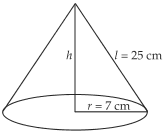

Thus, the required capacity of the conical vessel is 1.232 l.
(ii) Here, height (h) = 12 cm and l = 13 cm
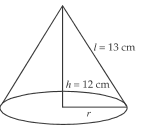
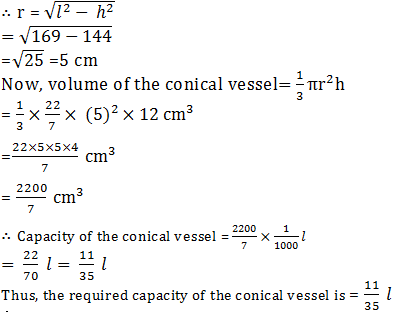
3
Answer
Here, height of the cone (h) = 15 cmVolume of the cone (v) = 1570 cm3
Let the radius of the base be ‘r’ cm

⇒ r2 = 102
⇒ r = 10 cm
Thus, the required radius of the base is 10 cm.
4
Answer
Volume of the cone = 48 πcm3Height of the cone (h) = 9 cm
Let ‘r’ be its base radius.

∵ Diameter = 2 × Radius
∴ Diameter of the base of the cone = 2 × 4 = 8 cm
5
Answer
Here, diameter of the conical pit = 3.5 m
= 38.5 m3
∴ 1000 cm3 = 1 l and 1000000 cm3 = 1m3
∴ 1000 x 1000 cm3 = 1000 l = 1 kl
Also 1000 x 1000 cm3 = 1 m3
⇒ 1 m3 = 1 kl
⇒ 38.5 m3 = 38.5 kl
Thus, the capacity of the conical pit is 38.5 kl.
6
(i) height of the cone
(ii) slant height of the cone
(iii) curved surface area of the cone.
Answer
Volume of the cone (v) = 9856 cm3Diameter of the base = 28 cm
⇒ Radius of the base =(28/2)cm = 14 cm
(i) To find the height Let the height of the cone be ‘h’ cm.
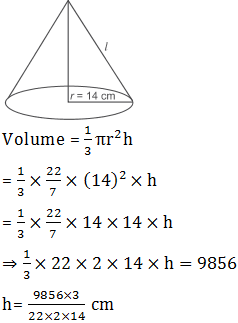
= 16 x 3 cm = 48 cm Thus, the required height is 48 cm.
(ii) To find the slant height Let the slant height be ‘ℓ’ cm.
∵ (Slant height)2 = (Radius)2 + (Height)2
∴ ℓ2 = 142 + 482
= 196 + 2304
= 2500 = (50)2
⇒ ℓ = 50
Thus, the required height = 50 cm.
(iii) To find the curved surface area
∵ The curved surface area of a cone is given by πrl
∴ Curved surface area = (22/7) x 14 x 50 cm2
= 22 x 2 x 50 cm2
= 2200 cm2
Thus, the curved surface area of the cone is 2200 cm2.
7
Answer
Sides of the right triangle are 5 cm, 12 cm and 13 cm.∵ The right angled triangle is revolved about the 12 cm side.
∴ Its height is 12 cm and base is 5 cm.
Thus, we have Radius of the base of the cone so formed (r) = 5 cm
Height (h) = 12 cm
Slant height = 13 cm
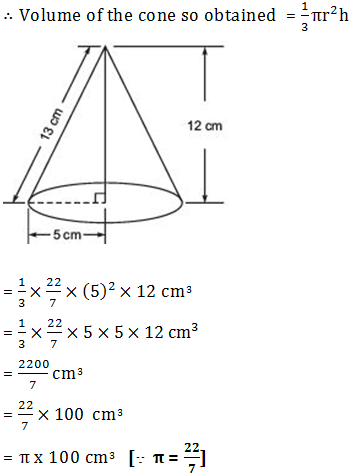
= 100 πcm3
Thus, the required volume of the cone is 100 πcm3.
8
Answer
Since the right triangle is revolved about the side 5 cm.∴ Height of the cone so obtained (h) = 5 cm
Radius of the cone (r) = 12 cm
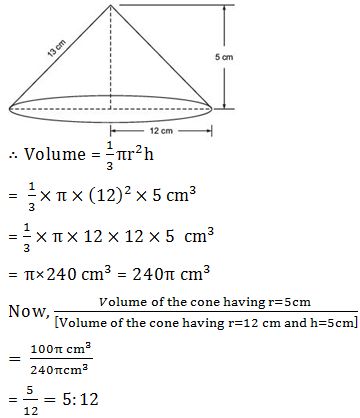
Thus, the required ratio is 5 : 12.
9
Find its volume. The heap is to be covered by canvas to πrotect it from rain. Find the area of the canvas required.
Answer
Here the heap of wheat is in the form of a cone such that Base diameter = 10.5 m⇒ Base radius (r) = (10.5/2)m = (105/20) m
Height (h) = 3 m Volume of the heap

Thus, the required volume = 86.625 m3
Area of the canvas
∵ The area of the canvas to cover the heap must be equal to the curved surface area of the conical heap.
∴ Area of the canvas = πrl
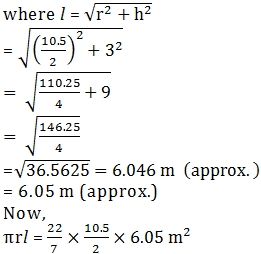
= 11 × 1.5 × 6.05 m2
= 99.825 m2
Thus, the required area of the canvas is 99.825 m2.
1
(i) 7 cm
(ii) 0.63 m
Answer
(i) Here, radius (r) = 7 cm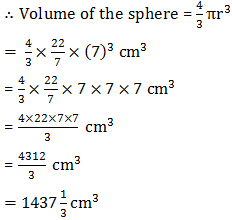
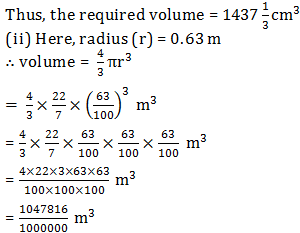
= 1.047816 m3 = 1.05 m3 (apπrox)
Thus, the required volume is 1.05 m3 (apπrox).
2
Answer
(i) Diameter of the ball = 28 cm∴ Radius of the ball (r) =(28/2) cm = 14 cm
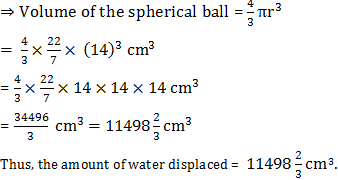
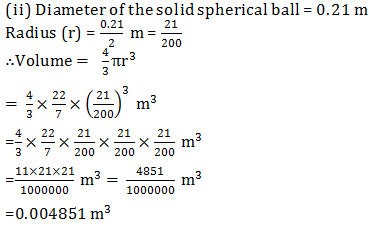
3
Answer
Diameter of the metallic ball = 4.2 cm⇒ Radius (r) = (4.2/2) cm = 2.1 cm
∴ Volume of the metallic ball =
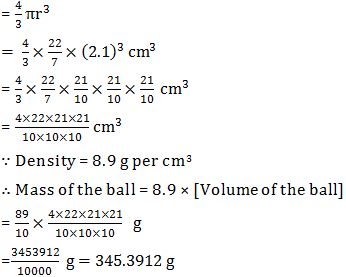
= 345.39 g (approx.)
Thus, the mass of ball is 345.39 g (aprrox.)
4
What fraction of the volume of the earth is the volume of the moon?
Answer
Let diameter of the earth be 2r.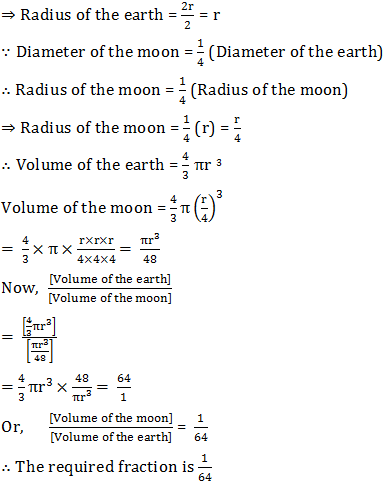
5
Answer
Diameter of the hemisphere = 10.5 cm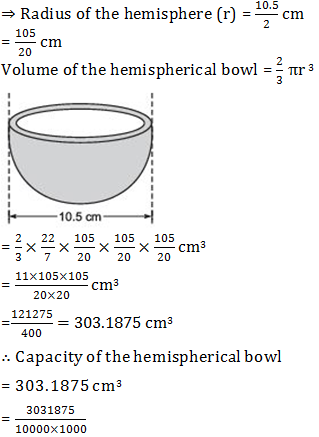
= 0.3031875 l
= 0.303 l (approx.) [∵ 1000 cm3 = 1 L]
Thus, the capacity of the bowl = 0.303 l (approx.)
6
Answer
Inner radius (r) = 1m∴ Outer radius (R) = 1 m + 0.01 m = 1.01 m
Now, outer volume of the hemispherical bowl
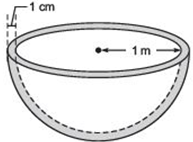
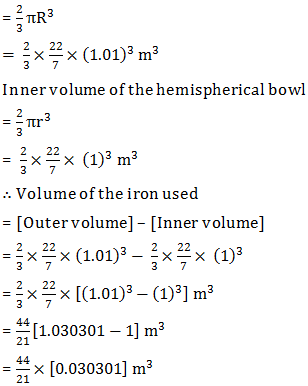
= 0.063487776 m3
= 0.06348 m3 (apπrox.)
Thus, the required volume of the iron = 0.06348 m3
7
Answer
Let ‘r’ be the radius of the sphere.∴ Its surface area = 4πr2
⇒ 4πr2 = 154
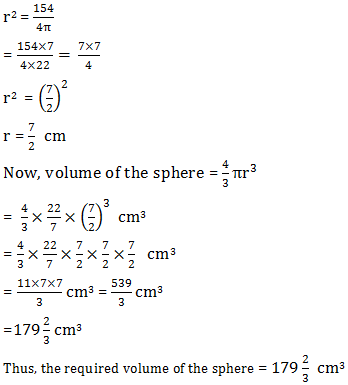
8
Answer
Total cost of white washing = ₹ 4989.60Rate of white washing = ₹ 20 per m

(i) To find the inside surface area of the dome:
∵ Radius of the hemisphere (r) = 6.3 m
Surface area of a hemisphere = 2πr2 m2
∴ Surface area of the dome
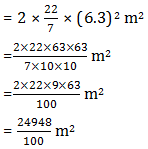
= 249.48 m2
Thus, the required surface area of the dome = 249.48 m2
(ii) To find the volume of air in the dome:
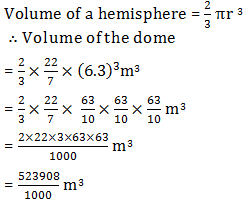
= 523.9 m3(approx.)
Thus, the required volume of air inside the dome is 523.9 m3 (approx.)
9
Answer
(i) To find r ':∵ Radius of a small sphere = r

(r’)3 = (3r)3
r’=3r
(ii) To find ratio of S and S ':
∵ Surface area of a small sphere = 4πr2
∴ S= 4πr2 and S ' = 4p(3r)2
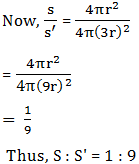
10
Answer
Diameter of the spherical capsule = 3.5 mm∴ Volume of the spherical capsule
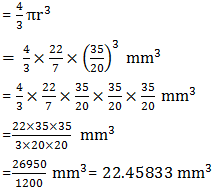
=22.46 mm3 (approx.)
Thus, the required quantity of medicine = 22.46 mm3 (approx).
1
Answer
Here, Height = 110 cmDepth = 25 cm
Breadth = 85 cm
Thickness of the plank = 5 cm
Cost of polishing
∵ Area to be polished =
[(110 x 85)] + [(85 x 25) x 2] + [(110 x 25) x 2] + [(5 x 110) x 2] + [(75 x 5) x 4] cm2
= [9350] + [4250] + [5500] + [1100] + [1500] cm2
= 21700 cm2
∴ Cost of polishing at the rate 20 paise per cm2

Cost of painting
∵ Area to be painted = [(75 x 20) x 6] + [(90 x 20) x 2] + [90 x 75] cm2
= [9000 + 3600 + 6750] cm2 = 19350 cm2
∴ Cost of painting at the rate of 10 paise per cm2
Total expenses = (Cost of polishing) + (Cost of painting)
= ₹ 4340+₹ 1935
= ₹ 6275
Thus, the total required expense = ₹ 6275.
2
Answer
For spherical part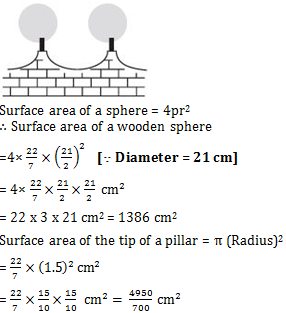
= 7.071 cm2
∴ Surface area of a wooden sphere to be painted silver = [1386 – 7.071] cm2
= 1378.93 cm2
⇒ Surface area of 8 wood spheres to be painted = 8 x 1378.93 cm2
= 11031.44 cm2
Now, the cost of silver painting at the rate of 25 paise per cm2
For cylindrical part Radius of the base of the cylindrical part (R) = 1.5 cm
Height of the cylindrical part (h) = 7 cm
∴ Curved surface area of the cylindrical part (pillar) = 2πRh
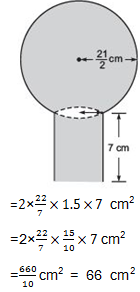
⇒ Total curve surface area of 8 pillars = 8 x 66 cm2 = 528 cm2
∴ Cost of painting black for 8 pillars at the rate of 5 paise per cm2
Total cost of painting Total cost of painting = [Cost of silver painting] + [Cost of black painting]
= ₹ 2757.86 +₹ 26.40
= ₹ 2784.26
3
Answer
Let the original diameter = d [Case I]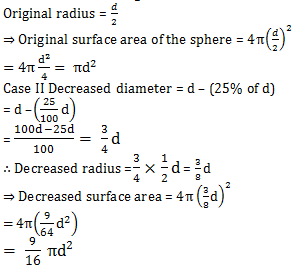
Per cent decrease in surface area Decrease in curved surface area = [Original surface area] – [Decreased surface area]
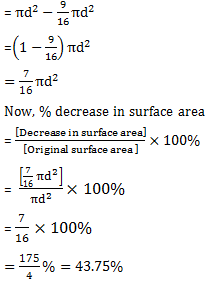
Thus, the required per cent decrease in curved surface area is 43.75%